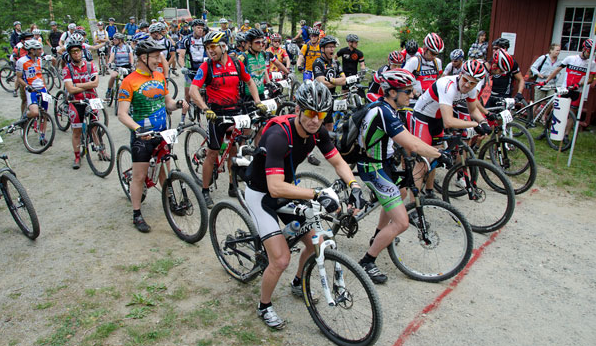Indoor cycling classes are the perfect theater for using creative imagery in coaching. Since we are riding bikes that go nowhere, the use of visualization techniques becomes necessary to break through those four walls enclosing the room, and is one of the unique aspects that sets indoor cycling apart from so many other group fitness classes.
Visualization coaching techniques allow you to connect with your indoor cycling students on a much deeper level. This helpful and educational seven-part series will cover a variety of scenarios that benefit from creative coaching techniques.
Part 1 discusses the power of using visualization. Parts 2 and 3 will provide colorful examples of expanding your coaching language. Further chapters will give specific cues for flats, climbs, high-intensity efforts, and warm-up and cool-down. You will never run out of things to say again!
Many instructors use only one method of imagery—the easiest and most common. They describe the road, its steepness, how fast they are going, or the scenery they are passing along the way. While there is nothing wrong with this type of imagery and it can certainly set the scene for your profile, there are many other creative ways to engage your students on a mind-body level and enhance their experience. These techniques will set you apart from the typical indoor cycling instructor.
Language is very powerful. Words can make you smile, make you sad or angry, and they can leave you confused for hours on end. Images are also very powerful; imagine watching an entire movie without sound. Usually you can figure out what is going on and feel almost as wide a range of emotions as if you had sound.
Words conjure up images that act on the brain to link associations to that image and to cause a physiological arousal in the body. These include an increase in heart rate, faster and deeper breathing, and activation of glands (releasing hormones) and organs (such as slowing digestion or shunting the blood as in the “fight or flight” response).

The brain and the central nervous system do not know the difference between what is real and what is imagined—your brain will elicit the same physiological responses when it is actually experiencing an event or when viewing the event on a screen. It can even happen when simply imagining taking part in an event.
That is why this technique is so powerful to help students engage and to surpass their own self-perceived limitations. Yes, we’re riding a bike indoors that goes nowhere, but in your mind, you can do anything you set your mind to. Let’s all go there together!

Try this test. Close your eyes and bring up the following images in your mind. Reflect for a moment, and ask yourself how they make you feel.
You are…
- Sitting on a calm beach in a beach chair, your feet stretched out in front of you on the soft sand. There is a warm sun and a gentle breeze caressing your face, a subtle smell of salt in the air, the gentle sound of the waves lapping on the shore. A seagull flies over and calls out to you…
- Sitting in your car in traffic at a red light on a hot day; the light turns green, no one moves, you are in a hurry. Finally two cars are able to get through; you creep forward and it turns red again and you’ve barely moved. After waiting 5 minutes for another green light, it happens again…
- Sitting on the edge of your seat in the second row watching your favorite baseball team. The game is tied in the final inning, there are two outs, your favorite player is up, the count is 3 and 2…the batter takes his place at the plate…and the pitcher winds up…
- Sitting at a doctor’s office waiting for the results of a test that had you worried for the past week…
- Sitting next to a bubbling stream with your best friend, not saying a word, soaking your feet in the cool water, listening to the sounds of nature…
- You are at the start of a mountain bike race, 2 minutes before the gun, your heart rate pounding, looking around at all the other riders, wondering if your training has been sufficient, noticing that these other riders look superior to you and in better shape, wondering if you are over your head, if the distance is too far, too steep, wondering why you signed up for this race after all…
- Poised at the start of the same race, your heart pounding, but filled with the satisfaction that you trained and prepared correctly, you tapered just enough the past few days, your legs are feeling strong; you look at the other riders, acknowledge that you are every bit as fit and prepared as they are, knowing you rode the course last week and are confident in your ability, except for that one steep scary section, but you will deal with that when you come to it—the gun is about to go off…
Each has a slightly different effect on you, your heart rate, your breathing, your bodily sensations. Some may raise your heart rate (sympathetic nervous system) and some lower it (parasympathetic nervous system). Raising the heart rate can be a negative or a positive thing; it can be due to stress (like in the traffic jam or worrying about the race) or it can be the excitement of an event you are passionate about (the baseball game or a race you are well prepared for).
Learning to use the power of words to conjure up images that create a positive effect in your students is a valuable skill. You can teach your students to tap into their own mind-body connection, allowing them to achieve higher levels of performance. It also sets you apart as a unique coach who empowers and motivates her riders.
How to use visualization and imagery

Visualization is simply imagining something, and then drawing a picture in your mind. The more vivid the picture, the more you excite the brain, which then arouses the necessary glands and the muscles to experience the action.
Not everyone excels at visualization, but it can be improved through practice. Similar to meditation, if the head is filled with other thoughts of the day, it will be difficult to paint a picture in your mind—you need to empty your mind of conflicting thoughts first.
If you find that you, or one of your students, have a hard time bringing up in vivid detail an imagined event, don’t give up! To be more effective, suspend judgment of yourself and try not to get frustrated. Simply try another visual if you are unsuccessful with the first.
On the other hand, if you are really good at visualization, it’s hard to imagine that everyone cannot do it easily. Your riders will need your patience and guidance to help them reach that point of seeing a picture in their mind, holding it in their mind’s eye, and reacting to it.
There are several approaches to visualization. Let’s look at the example of sitting on a beach. You can picture it through your own eyes, see your feet extended out in front of you in the sand, feel your arms resting lightly on the beach chair, turn your head to watch the surf, or look up to see a bird flying overhead.
Or, imagine this very same scenario as if you are watching yourself on a video. See yourself sitting in the chair and the scenery surrounding the image, the surf in the background and a bird flying overhead, but none of this is through your own eyes. The calming result of each technique is the same.
Visualization does not always need to include you, or even a bicycle; it can be a completely unrelated event while still causing the relaxing or stimulating effect you seek. In a cycling class, we might describe sitting on the beach or viewing a gentle waterfall if we want to induce a relaxing effect on our students. We might use a food analogy, and engage the sense of smell to inspire our students to think of a food that makes them happy. You can conjure up your favorite childhood memory, your favorite pet, or riding a thrilling roller coaster. The sky is the limit with creative visualization!


Good article. I have a number of profiles where I take my class on mountain passes, i.e. Ride the Rockies, or endurance energy rides,i.e. Pedal the Plains, and each profile I use visual cues.
I love this article! Being able to inspire our students is what keeps them coming back, I think.
This great, Jennifer, I needed this right now.
PS: Is that Hanging Lake in the photo?
Great article! I would love to use visualization in my classes for a change because I like to learn and grow in the way I insruct and this is a perfect way to add something new to keep my riders engaged. I look forward to the rest of your articles. Thank you!
Really nice article, Jennifer. One of the things I love so much about indoor cycling is that it can be a platform for this kind of training. Mental and physical training so support each other. I mostly use time trials for visualization so I am particularly eager to see how you use it in other modes. Good job!!
This is likely to be a very timely series for me as I have so few class members who wear heart rate monitors that I need to nail the perceived exertion cues……and I don’t think I’m too slick (as you mentioned, if you find a skill “easy” it’s hard to imagine that someone else doesn’t)
I am really trying to develope this skill to increase the level of motivation and focus in my classes. I always love how your master classes have a story to tell and images to guide the rider. I have gotten better at coaching and cueing so I want to really boost my mental imagery skills. Thanks Jennifer!!! This is just what I need!
I love visualization and am looking forward to the rest of the series – this is a great beginning! Lisa
Great article Jennifer,
that is a big help for me. because I use it less!